Introduction
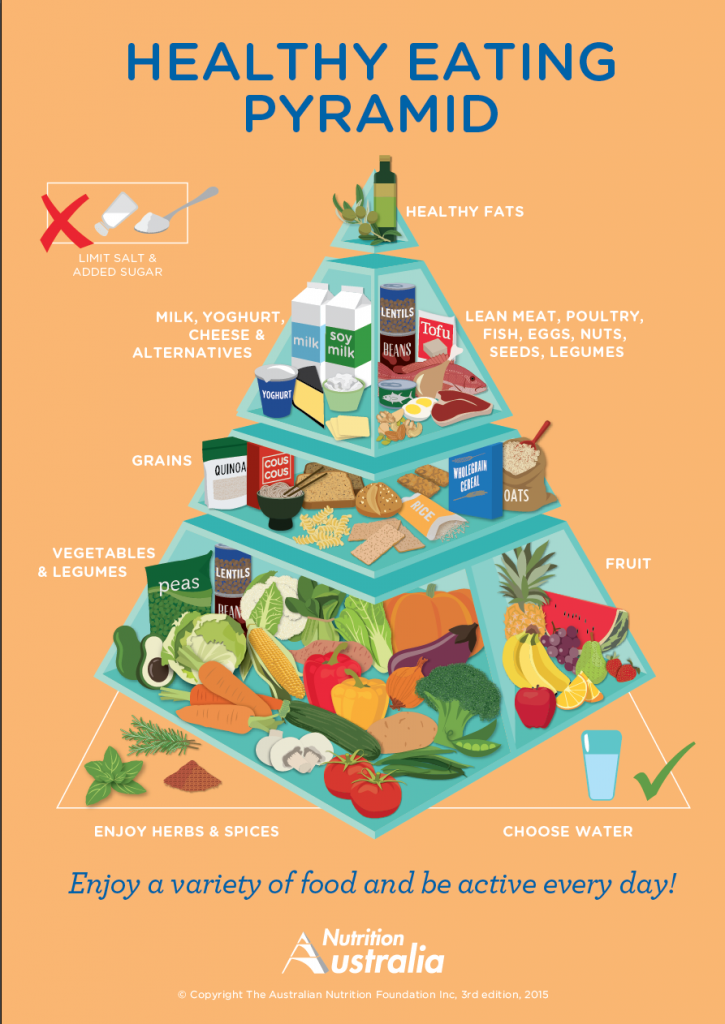
The Healthy Eating Pyramid is a simple visual guide to the types and proportion of foods that we should eat every day for good health.
It contains the five core food groups, plus healthy fats, according to how much they contribute to a balanced diet based on the Australian Dietary Guidelines (2013).
The layers of the Pyramid are based on the recommended food intake for 19–50 year-olds according to the Australian Dietary Guidelines (2013). However, the proportions and placement of each food group are generally applicable to all age groups from 1–70 years.
The Healthy Eating Pyramid encourages Australians to enjoy a variety of foods from every food group, every day.
The layers of the Healthy Eating Pyramid
The foundation layers
The foundation layers include the three plant-based food groups:
- vegetables and legumes
- fruits
- grains
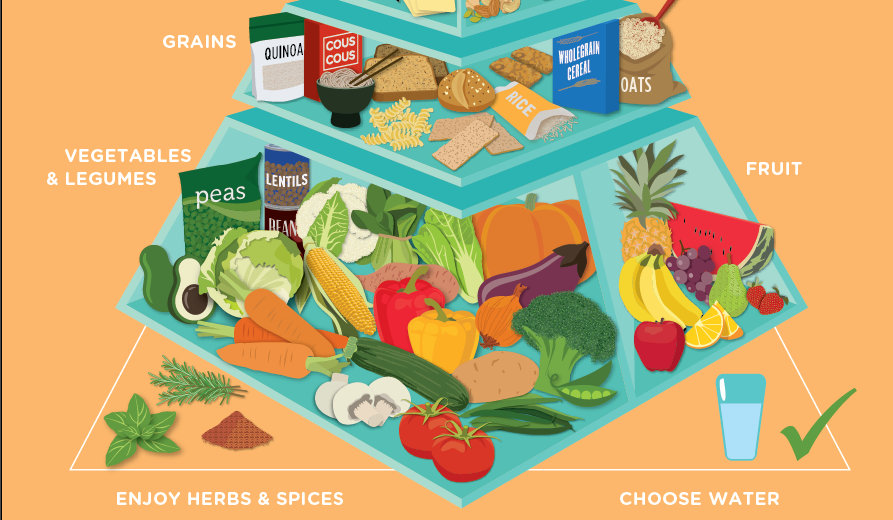
These layers make up the largest portion of the Pyramid because plant foods should make up the largest portion of our diet – around 70% of what we eat!
Plant foods contain a wide variety of nutrients like vitamins, minerals, phytpchemicals and antioxidants. They are also the main source of carbohydrates and fibre in our diet.
Older children, teens and adults should aim to have at least 2 serves of fruit and 5 serves of vegetables or legumes each day.
From the grains food group, choose mostly wholegrains (such as brown rice, oats and barley), and wholemeal/wholegrain/high cereal/fibre varieties of bread, pasta, crisp breads and cereal foods (over highly processed, refined varieties).
Remember:
- The Healthy Eating Pyramid is a simple visual guide to the types and proportion of foods that we should eat every day for good health.
- The foundation layers make up the largest portion of the Pyramid because plant foods should make up the largest portion of our diet.
- Choose mostly wholegrains over highly processed, refined varieties.

Creamy chicken laksa recipe
Hit three of the four layers with this zesty dinner – vegetables, grains and fats. Who doesn’t love a classic chicken laksa?
The middle layer
The middle layer includes the milk, yoghurt, cheese & alternatives and the lean meat, poultry, fish, eggs, nuts, seeds, legumes food groups.

Foods in the milk, yoghurt, cheese & alternatives group primarily provide us with calcium and protein, plus other vitamins and minerals. This food group also refers to non-dairy options such as soy, rice or cereal milks which have at least 100mg per 100ml of added calcium.
Foods in the lean meat, poultry, fish, eggs, nuts, seeds, legumes section are our main sources of protein. But each food also provides a unique mix of nutrients, including iodine, iron, zinc, B12 vitamins and healthy fats. We should aim to have a variety of animal and plant-based options from this food group.
The top layer
The top layer refers to healthy fats. We need small amounts of healthy fats every day to support heart health and brain function. We should choose foods that contain healthy fats instead of foods that contain saturated fats and trans fats.

Choose unrefined polyunsaturated and monounsaturated fats from plant sources, such as extra virgin olive oil, nut and seed oils. Limit the amount of saturated fat you consume and avoid trans fats.
We also get healthy fats from foods in the other food groups, such as avocados, nuts, seeds and fish, so we only need a little bit extra from oils and spreads each day.
Remember:
- Foods in the milk, yoghurt, cheese & alternatives group primarily provide us with calcium and protein, plus other vitamins and minerals.
- Foods in the lean meat, poultry, fish, eggs, nuts, seeds, legumes section are our main sources of protein.
- We need small amounts of healthy fats every day to support heart health and brain function.
- Choose unrefined polyunsaturated and monounsaturated fats from plant sources, such as extra virgin olive oil, nut and seed oils.
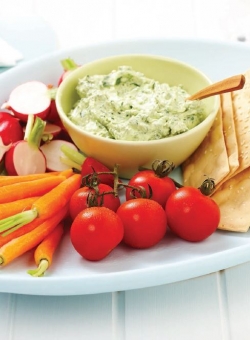
Basil and lemon dip recipe
Pair this herby-lemony dip with some vegetable sticks for a quick snack, and tick off the foundation layer.
Additional messages
Enjoy herbs and spices
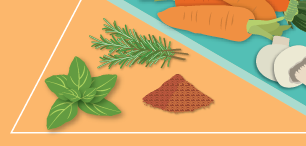
Herbs and spices provide a wonderful range of flavours and aromas to our food. Many herbs and spices have health-promoting properties, but since we tend to eat them in smaller amounts their primary purpose is to flavour and colour our meals.
Cooking with fresh, dried or ground herbs and spices is an easy way to create foods that suit your tastes and increase your enjoyment of home-made meals without needing to use salt when cooking or eating.
Choose water

Water is the best drink to stay hydrated and it supports many other essential functions in the body. Choose water as your main drink, and avoid sugary options such as soft drinks, sports drinks and energy drinks.
Limit added salt and sugar
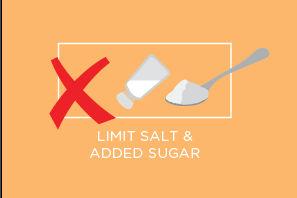
The Healthy Eating Pyramid reminds us to limit our intake of added salt and sugar. The average Australian already consumes too much salt and added sugar, which is linked to increased risk of diseases, such as heart disease, type 2 diabetes and some cancers.
Cooking your own meals at home and choosing whole foods or minimally processed foods will also help to limit how much salt and added sugar we consume.
Salt (sodium)
Sodium is found in salt and is naturally occurring in some foods. While we do need small amounts of sodium for good health, too much salt is linked to increased risk of high blood pressure, which can increase your risk of cardiovascular (heart) and kidney disease.
Avoid adding salt to food when cooking and eating and read labels to choose foods that have less than 120mg of sodium per 100g.
Sugar
Consuming a lot of added sugars, especially from foods like lollies, chocolate, cakes, biscuits, desserts and soft drink, can add extra kilojoules to your diet. This can lead to weight gain and increase your risk of developing type 2 diabetes, cardiovascular disease and some cancers. Too much sugar can also cause dental cavities.
Most fruits, vegetables, legumes and unsweetened dairy foods contain small amounts of naturally occurring sugars which are not harmful. Choose fresh or minimally processed varieties of these foods and check the ingredients on all packaged foods and drinks to see if sugar has been added.
Remember:
- Many herbs and spices have health-promoting properties.
- Water is the best drink to stay hydrated and it supports many other essential functions in the body.
- Cooking your own meals at home and choosing minimally processed foods will help limit added salt and sugar.




